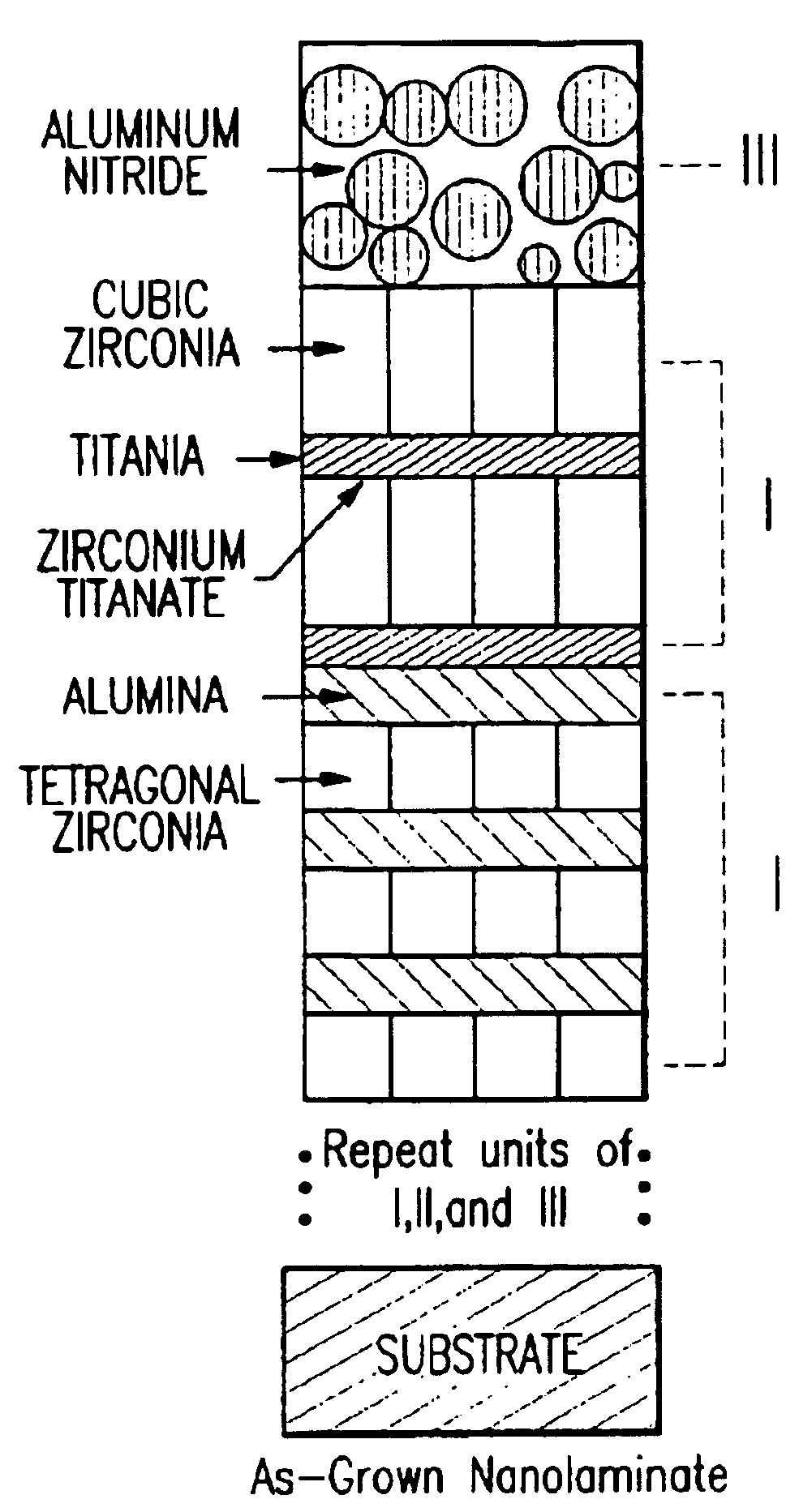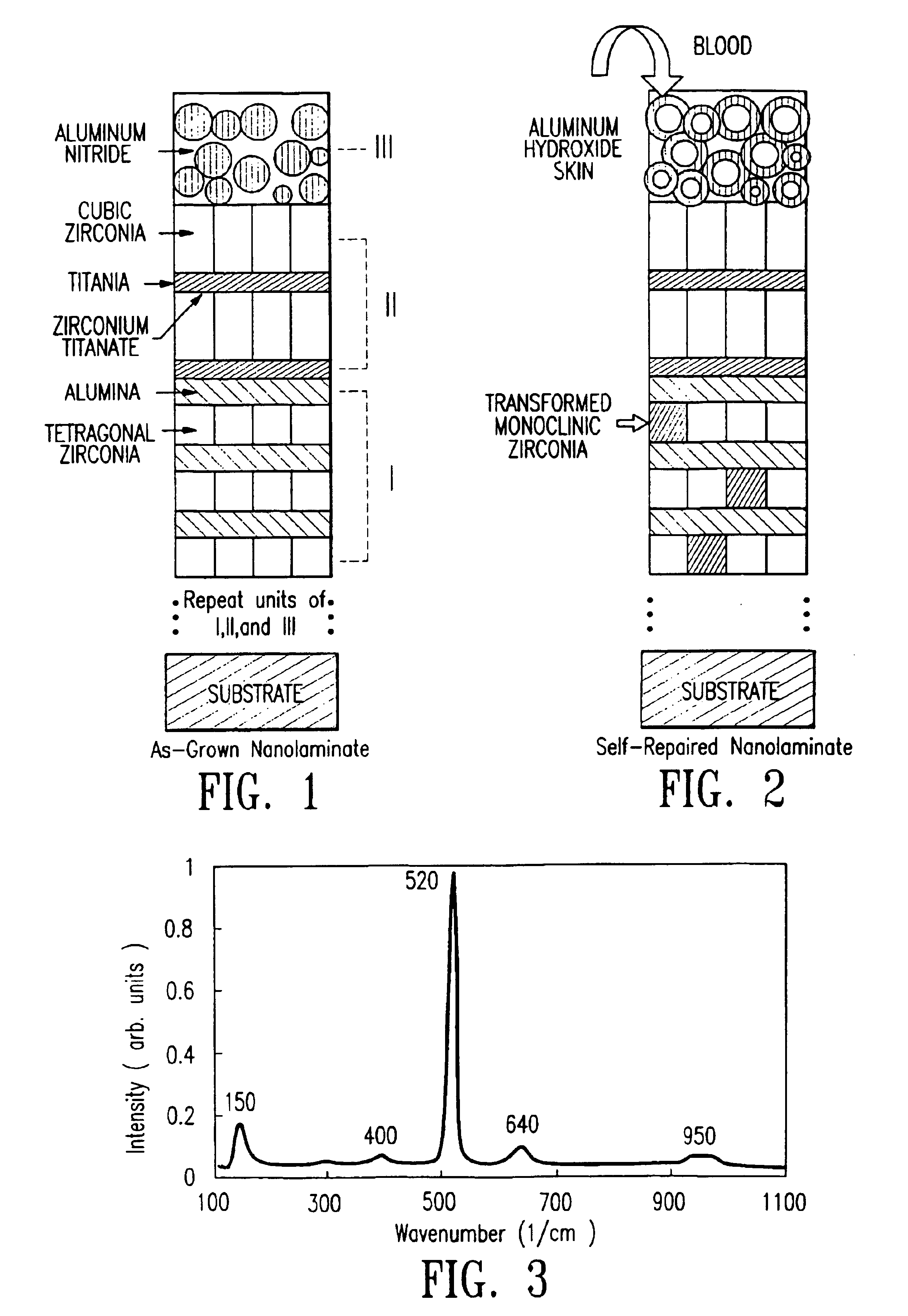Self-repairing ceramic coatings
a ceramic coating and self-repairing technology, applied in the direction of prosthesis, instruments, ligaments, etc., can solve the problems of thrombosis and embolism formation, limiting factors, mechanical failure of implants,
- Summary
- Abstract
- Description
- Claims
- Application Information
AI Technical Summary
Benefits of technology
Problems solved by technology
Method used
Image
Examples
example i
Transformation-Toughening Zirconia-Alumina Coatings
Nanolaminates consisting of polycrystalline zirconia and vitreous alumina bilayer stacks were grown at room temperature by reactive sputter deposition. The formation of tetragonal zirconia in the as-grown material was consistent with a finite crystallite size effect. Solely the tetragonal phase was produced in zirconia layers whose thickness was less than a critical value, e.g., less than 6 nm for room temperature growth. With respect to in-service transformation-toughening, high resolution transmission electron microscopy (HREM) was used to study the post-deposition, stress-induced tetragonal to monoclinic zirconia transformation, and its plane and direction invariants were identified.
The transformation was localized to nano-sized regions within individual zirconia layers, constrained by the alumina. The macroscopic effect of the toughness resulting from this transformation was confirmed by scanning electron microscopy of a cross-s...
example ii
Cubic Zirconia and Zirconia Titanate Formation Zirconia-Titania Nanolaminates at Room Temperature
As the thickness of each constituent layer in a nanolaminate decreases, the interface between layers plays an increasingly important role in determining the overall properties of the coating. In turn, chemical reactivity between constituents plays an important role in determining the properties of the interface, even at low growth temperature. To illustrate this point, two pseudobinary oxide systems that represented extremes in chemical reactivity between constituents were compared, namely, zirconia-alumina and zirconia-yttria. The pseudobinary equilibrium phase diagram of zirconia and alumina showed very limited mutual solid solubility and no compounds. On the other hand, the pseudobinary phase diagram of zirconia and yttria showed a series of solid solutions (alloys) covering the entire composition range from pure zirconia to pure yttria, as well as compounds. These two model systems a...
example iii
Nanocrystalline Aluminum Nitride for Self-Sealing Corrosion Protection of Steel
Traditionally, ceramic coatings are used to protect an underlying material from corrosion by providing an inert, non-porous barrier to diffusion. In that case, any defect in the coating, such as a microscopic pore or pinhole, is a possible source of failure due to pitting corrosion. In addition, polycrystalline coatings with a typical columnar crystal structure are intrinsically vulnerable, because this microstructure provides fast diffusion paths to the substrate. To remedy the intrinsic problem of a columnar microstructure, multilayer coatings may be used to interrupt crystallite growth. However, pitting corrosion due to microscopic defects is still a concern.
The present inventors identified another, active, type of corrosion protection by ceramic coatings, referred to here as “self-sealing” behavior. To develop the self-sealing ceramic coating aluminum nitride coating on steel, as the prototype materia...
PUM
| Property | Measurement | Unit |
|---|---|---|
| Thickness | aaaaa | aaaaa |
| Thickness | aaaaa | aaaaa |
| Thickness | aaaaa | aaaaa |
Abstract
Description
Claims
Application Information
 Login to View More
Login to View More - R&D
- Intellectual Property
- Life Sciences
- Materials
- Tech Scout
- Unparalleled Data Quality
- Higher Quality Content
- 60% Fewer Hallucinations
Browse by: Latest US Patents, China's latest patents, Technical Efficacy Thesaurus, Application Domain, Technology Topic, Popular Technical Reports.
© 2025 PatSnap. All rights reserved.Legal|Privacy policy|Modern Slavery Act Transparency Statement|Sitemap|About US| Contact US: help@patsnap.com


